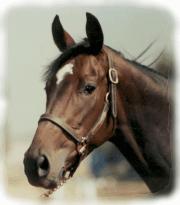A Horse, of Course with Don Blazer |
If you enjoy learning about horses, then you'll love our online courses. Each month you'll find a new column on our web site. We hope you'll enjoy it, and maybe e-mail us with questions or suggestions for other columns. A Horse, Of Course is a monthly column syndicated by Success Is Easy. If you like the column, call your local newspaper, or local horse publication and ask them to subscribe by contacting Success Is Easy. |
The Fourth Secret of Perfect Horsemanship Don Blazer copyright©2009 Your success lies within. When you follow your heart and you practice non-judgment you are on the path to perfect horsemanship. Practicing the fourth secret will change everything about the way you train and handle horses. Horses, as humans, are herd animals. Survival is the first concern. The actions and focus of horses, as they are with humans, always begin and end with themselves. Horses, as humans, seek the acceptance of the herd, and the praise of other herd members. Understanding that, you can understand why the fourth secret has two steps. To reach perfect horsemanship you must first 4. Give. That is the secret! The first who needs forgiveness is you. Yesterday is gone and will never return. While you may wish you had done things differently or behaved in a different way, you cannot change what is past. Don't live with "regret" or "guilt" or the wish for what "might have been." Simply forgive yourself and begin your next moment with the desire to forgive and give. Forgive those you think have wronged you. Forgive the mistakes others made. Forgiveness has no "debt". When you have forgiven, it is over and all that is to come is new. When you have forgiven, you have no fears, frustrations or disappointments associated with your horse. You have only the promise of a new beginning. And the new beginning is the second step: "giving" not "taking." You must change your way of thinking about training and handling horses, but not necessarily what you do physically. The most common and constantly used behavior modifications with horses are "habituation/desensitization" and "positive and negative reinforcement." Habituation and desensitization are simple forms of learning. The horse initially responds to a stimulus and eventually learns to respond less and less or not at all. It is habituation and desensitization we use to eliminate "spookiness" in a horse. We want the horse to get over the spookiness so that he can focus on what we want to teach, or to keep him listening to our requests. "Flooding" or "sacking out" are forms of habituation and desensitization and they are also a way we "take" from the horse instead of giving. While flooding or sacking out have been used for years and are still used with results, they are not the way to perfect horsemanship. There is almost always too much risk of injury or punishment to the horse when we "take" by forcing the horse to tolerate something or accept something which frightens him. Tying a horse hard and fast to a snubbing post will "take the fight out of him." Why not "give" the horse an opportunity to become familiar with something by allowing him to test it with his senses of smell, feel, sight, taste and/or hearing? Why not "give" the horse lessons over a period of time on standing and being tied? Because it takes time? Yes, it takes time. But perfect horsemanship isn't instantaneous. Positive reinforcement is the adding of something---a reward for having performed as requested. This is easily understood as "giving." Positive reinforcement teaches the horse to become an active participant, seeking the correct answer. But positive reinforcement can easily lead to unwanted behaviors. A horse sees you coming and knows you are bringing food. In his excitement, he kicks the stall wall, and you hurry with the food to stop the kicking. Repeat this several times and the horse soon becomes an obnoxious and dangerous problem. In that instance you have not "given", but have "taken" away your leadership position. Think rather than react and do not feed until the horse is quiet. You must "give" leadership, not abandon it. Negative reinforcement is the removal of something which is uncomfortable. The shortening of the reins sets a bit barrier which is somewhat uncomfortable. You give the horse leg cues to round up the body and find a shorter frame and bit pressure becomes nonexistent…a negative reinforcement that the shorter frame is correct. Leg pressure is reduced when the horse rounds into the proper frame and another negative reinforcement has been applied. Riding forward both legs apply equal light contact. To turn left, the left leg contact is removed and right leg pressure is increased. This is an example of "giving" the horse an option. The right leg has blocked movement in that direction, but the left leg has opened the door for the horse to move through. "Taking" leaves no options. When you have mastered the fourth secret, you always find a way to give rather than take. Don Blazer is the author of Nine Secrets of Perfect Horsemanship, a book he wrote for his granddaughter who won an AQHA World Championship in Youth Trail (2008). To read about the first three secrets, please visit the Archives Page. Visit A Horse, Of Course on the Internet at www.donblazer.com |
